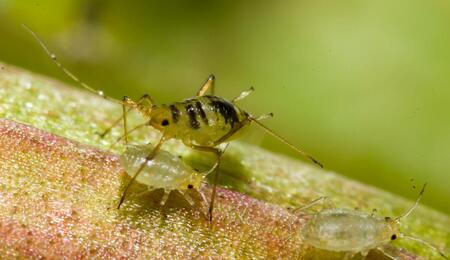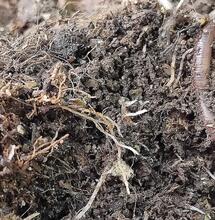How to Control Pests in Your Cannabis Garden?

Summer is the time for growing your cannabis crops to their full potential. It's also the season of ravenous bugs, hungry for your leafy green friends. Cannabis harvests can be marred by unwelcome critters. Prevention is the best measure to protect your crops from any bothersome bugs interested in invading your garden. Fortunately, there are many natural solutions that you can use for successful pest control action in your cannabis garden.
In Cannabis cultivation, pests are any organisms that can cause damage and leave a trail of destruction in your garden. The sooner the pesky critter is detected, the easier it is to control the outbreak. Cannabis pests include various bugs, aphids, spiders, mites, caterpillars, fungi, bacteria, viruses, and even birds and grazing animals. Outdoor gardens are often prone to pests infestations because plants are exposed to the elements of nature. However, an infestation can, without a hitch, also occur when farming marijuana plants indoors. In this article, we discuss five of the most common pests in Cannabis crops and how to prevent them with natural, chemical-free pesticide solutions.
Five Common Invaders in Cannabis Gardens
Bud worms. These are not your ordinary garden trespassers. Budworms are inch-long caterpillar-looking vermins you want immediately removed once you spot their eggs. All budworms are the larval stage of certain moths. They are called budworms because they burrow into the flower buds of marijuana and eat the fruit inside out. Budworms also attack other crops such as tobacco, spruce, cotton, various vegetables, and can even eat the buds of flowers such as petunias and geranium.
Powdery Mildews. Detecting plants with distinctive white powdery mold spots on the leaves is a common sight for many gardeners. Whether you are growing marijuana or other cultivars, powdery mildew is a pretty common disease. It may look ugly, especially when it spreads on edible crops, but it can be reasonably easily handled. Powdery mildew outbreaks are attributed to several species of fungi.
Fungus Gnats. Who on earth would like to smoke their buds spiced up with bugs? Fungus gnats can easily get trapped in resinous flowers. However, that's not the biggest issue they can cause. They are tiny, no more than 4 mm long, gray or black, and can be easily dismissed as mosquitoes. Fungus gnats feed on roots and other plant material and leave behind translucent larvae eggs. They are one of the most common reason for root rot.
Spider Mites. This suctorial vermin attaches to plants and feeds on valuable nutrients and chlorophyll from the leaves. Left untreated, it will ravage your crops. White, black or yellow colorations may indicate an ongoing spider mites infestation in your garden.
Aphids. There are several types of aphids, such as Greenflies and Blackflies. Barely visible and easy to miss, aphids are 1-10 millimeter long vandals that can reproduce quickly and cause cannabis leaves to curl and yellow. Apart from the fact they can be highly destructive, aphids also attract other pests such as ants.

Basic Guidelines to Keep Cannabis Pests at Bay
The following guidelines can help you protect your cannabis garden from common pests.
- If you are growing indoors, ensure that your crops are entirely isolated from outside interferences. This means filling any gaps or cracks in the walls or between the window or door panels with spray foam or caulk and placing filters when installing airflow infrastructure.
- Enter the grow room with clean clothes that you don't use for going outside. Wash your hands before you touch plants.
- Keep any other equipment that you use for growing clean, too. For example, if you transplant a plant to a bigger container, ensure it's well-washed and doesn't have any dirt before you fill it with new soil.
- Always keep a magnifying glass at hand. This is a very helpful tool for inspecting plants for tiny critters invisible to the eye.
- If you detect that one or more of your plants are not doing well, if there are areas that appear yellow, ill, or anything odd, separate them from the rest to avoid cross-contamination with healthy plants.
- Parts of the plant that appear ill-looking should be removed to avoid spreading the disease further or to other grow containers.
How to Deal with Bud Worms?
Try not to curse Mother Nature while you are figuring this one out. Budworms are the worst of the worst. Any bud that looks fragile, drying, or appears to have a small hole in it, could be a sign of budworm infestation. Rot from budworms may be accompanied by dying leaves near the affected cola.
If you notice anything suspicious like that, you must inspect the bud. Pull away the bud from the plant and also check any ill-looking leaves. Look for sand-grain balls, usually black or brown. That, my friend, is caterpillar poop. What to do next? Follow the poop until you find a worm or a small hole where the worm is hiding. Do not ever quit on finding that worm! Find it and feed it to the birds.
After you are done with the worm, cut off any affected buds and cleanse your plants from any worm poop you see. Most budworm eggs appear just on the sides of the buds, and some could also remain attached to the undersides of the leaves. Use a knitting needle or wooden toothpick to remove the eggs. Use a magnifying glass to double-check that all poop is removed.
Preventive treatments against budworms include solutions containing Bacillus thuringiensis (Bt), which is basically introducing soil bacteria that leeches toxic proteins for caterpillars and other insects. Spray early and spray regularly if you face budworm issues repeatedly. Routinely look for any visible caterpillars, which are usually active in the evening and hide near the base of the plants during the daytime.

How to Deal with Powdery Mildew?
Like any good fungus, powdery mildew appreciates humid conditions. Overexposure to dump moist air increases the chances for powdery mildew outbreaks or other fungi infestations.
Fungi spores primarily thrive on plants but can also be found in soil, compost, and other plant material. Left unchecked, fungi can quickly spread from plant to plant. Lack of airflow and limited grow space increases the risk of powdery mildew indoors.
There are several prevention strategies that you can take to protect your cannabis plants from fungi infections. First, routinely clean your garden tools such as pruners and trowels, especially after working with diseased plants and plant debris. Wash over with sanitizing agents such as white vinegar, rubbing alcohol, or hydrogen peroxide.
If you notice powdery mildew on some plants, avoid watering overhead. Powdery mildew spreads when the leaves are constantly moist or when water is splashed from a plant that is already infected. So, you want to water the soil below the plant. A drip irrigation system also works well in this case.
Powdery mildew also indicates that plants struggle with a lowered immune system. Use nutritious additives such as compost tea or aloe vera extract to replenish the garden soil. This will help the plants to absorb more nutrients and strengthen immunity, much needed to combat fungi invaders. And when mildew spread is hard to contain, use neem oil. If you have young cannabis plants affected by powdery mildew, spray with neem oil weekly as part of your organic pest control plan. Do not dispense neem oil once the plants begin to form flowers.
How to Deal with Fungus Gnats?
Similarly to powdery mildew, you want to control moisture in the growing environment. Do not overwater plants and keep humidity levels low for the time being when dealing with fungus gnats.
To prevent the fungus gnats lay their eggs in the soil, create a thick layer of sand or perlite which will trap the eggs and effectively kill them. You can also try solutions such as Gnatrol and Gnat Nix that stimulate the growth of beneficial bacterial colonies that feast on gnat eggs. You can also use yellow sticky traps to entrap adult gnats and prevent them from hatching more eggs. Yellow sticky traps are also handy for many other insect pests, including whiteflies, greenflies, thrips, and leaf miners that may be after your garden.

How to Deal with Spider Mites?
Look for spider mites on the underside of the leaves. These pesky critters create tiny holes in the leaves as they feast on leaf juices. Use a magnifying glass because they are from the hard-to-spot bunch. Another sign that your marijuana plants might be affected by mites is the appearance of miniature cobwebs covering the foliage.
Warm and dry growing environments are very much inviting for spider mites. So, if growing indoors and suspect mites problem, ensure lower temperatures are in place and increase room humidity.
Mites can also be combated with several natural insecticides. Pyrethrum, which is extracted from chrysanthemum flowers, can help eliminate mites in young cannabis plants. Apply pyrethrum up to four times in the duration of two weeks to solve a spider mites problem efficiently.
For spider mites in flowering cannabis plants, opt for organic limonoids-based sprays such as Azamax. A bottle of Azamax is a bit expensive, but it will most likely last you for several years and more.
How to Deal with Aphids?
Aphids are capable of destroying entire crops. Some types of aphids attack the foliage; others attack the roots. It may be a bit overwhelming to fight aphids when growing indoors. But the first step is to relocate any affected plants to stop spreading the bugs everywhere. After pruning off damaged and infected leaves, spray the plants with a garlic oil mixture or a vinegar and water solution to fight off these invaders. Spray every day until the plants are aphid free.
For root aphids, you want to utilize a Spinosad-based insecticide or introduce Beauveria, a fungus that contains spores that will attack the root aphids. These solutions can be used in combination with pyrethrum and neem oil.
For outdoor cannabis gardens, several natural "predators" can as well help in aphids pest control efforts. One option is to introduce beneficial bugs, like ladybugs and lacewings, as a natural way to eliminate aphids. It is also good to know that plants such as mint, fennel, yarrow, dill, and dandelions may attract aphids. Therefore, if you grow any of these plants, keeping them away from your cannabis plants or entirely relocating them from your garden is recommended.
In sum, pest control in cannabis gardens can be, for the most part, done with natural solutions. Avoid chemical pesticides as most such products will do more harm than good. Chemical solutions can help exterminate any pest more efficiently, but they can open other problems and are also not good for the soil and the environment. With a little patience, research, and trying out what works and what not, you can practically fix any pest issue in your garden.
Good luck fighting the bugs!














